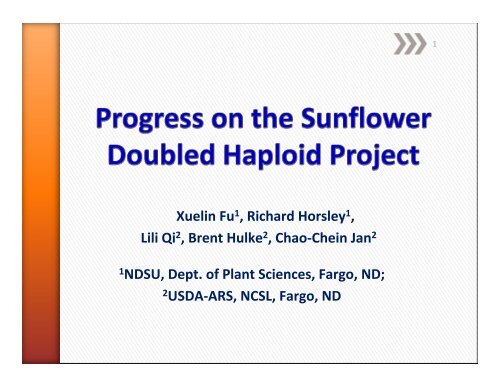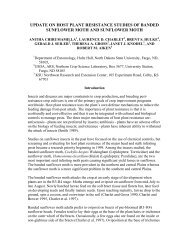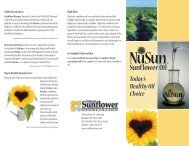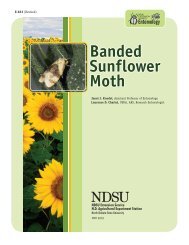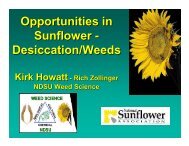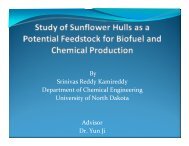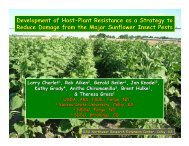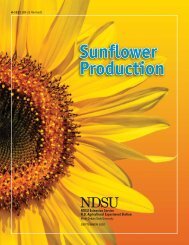Progress on the Sunflower Doubled Haploid Project - National ...
Progress on the Sunflower Doubled Haploid Project - National ...
Progress on the Sunflower Doubled Haploid Project - National ...
You also want an ePaper? Increase the reach of your titles
YUMPU automatically turns print PDFs into web optimized ePapers that Google loves.
1Xuelin Fu 1 , Richard Horsley 1 ,Lili Qi 2 , Brent Hulke 2 , Chao‐Chein Jan 21NDSU, Dept. of Plant Sciences, Fargo, ND;2USDA‐ARS, NCSL, Fargo, ND
Introducti<strong>on</strong>An<strong>the</strong>r cultureO<strong>the</strong>r methods triedFuture plansAcknowledgements2
Doubling <strong>the</strong> haploid chromosome numberwill produce a doubled haploid (DH).Androgenesis c<strong>on</strong>sists of producti<strong>on</strong> of plantsfrom an<strong>the</strong>rs or microspores cultured in vitro.<strong>Doubled</strong> haploids have important applicati<strong>on</strong>s inplant genetic and breeding research.4
In sunflowers, some methods such as an<strong>the</strong>rculture, microspore culture and irradiati<strong>on</strong> ofpollen grains have been tried by researchersto produce DHs.An<strong>the</strong>r culture is <strong>on</strong>e of <strong>the</strong> most usedmethods. Cultivated sunflowers have proven tobe very recalcitrant in an<strong>the</strong>r culture, especiallyfor shoot regenerati<strong>on</strong>.5
Until now, n<strong>on</strong>e of <strong>the</strong> techniques used havebeen successfully applied to <strong>Doubled</strong> <strong>Haploid</strong>breeding programs of sunflowers.In October 2010, <strong>the</strong> <strong>Sunflower</strong> <strong>Doubled</strong><strong>Haploid</strong> <strong>Project</strong> was initiated by <strong>the</strong> USDA.This report gives <strong>the</strong> progress of this projectfor 2011.6
An<strong>the</strong>r cultureBasic processA) inbred lines and amphiploid hybrids were tested.B) An<strong>the</strong>rs with microspores at <strong>the</strong> late uninucleatestage were used for culturing, which are light yellowwhitein appearance.microsporesat <strong>the</strong> lateuninucleatestage7
Embry<strong>on</strong>ic callus or Embryo‐Like‐Structures(ELS) inducti<strong>on</strong>An<strong>the</strong>r culture of inbred linesHA89, HA410, RHA280, RHA274, Peredovik, RHA801,Seneca and Hopi Dye.Our experiment used L9 (3 4 ) orthog<strong>on</strong>al design.9
Table 1 L9 (3 4 ) orthog<strong>on</strong>al design for factors and levels <strong>on</strong>embry<strong>on</strong>ic callus inducti<strong>on</strong>ExperimentandMediumcode1-Genotype2 –Sucrose(g/l)Factors3-Phytohorm<strong>on</strong>e(mg/l)4-Organic additi<strong>on</strong>(per litre medium)E1 RHA274 120 BAP0.5+NAA0.5 No additi<strong>on</strong>E2 RHA274 90 BAP1.0+NAA0.5 CH 500mgE3 RHA274 30 BAP0.5+2,4-D 0.5 Coc<strong>on</strong>ut water 100mlE4 HA89 120 BAP1.0+NAA0.5 Coc<strong>on</strong>ut water 100mlE5 HA89 90 BAP0.5+2,4-D 0.5 No additi<strong>on</strong>E6 HA89 30 BAP0.5+NAA0.5 CH 500mgE7 Peredovik 120 BAP0.5+2,4-D 0.5 CH 500mgE8 Peredovik 90 BAP0.5+NAA0.5 Coc<strong>on</strong>ut water 100mlE9 Peredovik 30 BAP1.0+NAA0.5 No additi<strong>on</strong>10
Notes:1) Basic medium: MS (macro +micro‐elements)+Agar 7g/l + Morel and Wetmore’s mediumvitamins + a series of amino acids (AA) .2) BAP‐‐‐6‐benzylaminopurine, 2,4‐D‐‐‐2,4‐dichlorophenoxyacetic acid, NAA‐‐‐naphthlceticacid.3) Every experiment c<strong>on</strong>sisted of 3 replicati<strong>on</strong>s(petri dishes) , each with 150~ 200 an<strong>the</strong>rs.11
Table 4 T Grouping of embry<strong>on</strong>ic callus orELS inducti<strong>on</strong>T Grouping Mean N ExperimentA 205.77 3 E3B 67.87 3 E7B 8.99 3 E2B 5.00 3 E5B 1.78 2 E8B 0.74 2 E9B 0.61 3 E1B 0 3 E6B 0 3 E4Note: Means with <strong>the</strong> same letter are not significantly different.14
ELS produced in <strong>on</strong>e an<strong>the</strong>ra cluster ofELSdistributedal<strong>on</strong>g <strong>the</strong>wholean<strong>the</strong>rELSdevelopmentin an<strong>the</strong>rs ofRHA274 <strong>on</strong>medium E3many ELS produced in all fivean<strong>the</strong>rs of <strong>on</strong>e flower15
In our experiment, we discovered a genotypemediumcombinati<strong>on</strong>, E3, which had <strong>the</strong> highestinducti<strong>on</strong> of ELS.The effectiveness of this medium was c<strong>on</strong>firmedusing more inbred lines and interspecificamphiploids.16
Table 5 Inducti<strong>on</strong> results of embry<strong>on</strong>ic callus or ELSMedium Material No. of an<strong>the</strong>rsculturedNo. ofcallus orELSrate of callus(%)E3 HA89 350 10 2.86±0.12E3 HA410 575 109 18.96±1.43E3 RHA274 530 909 171.51±20.67E3 Peredovik 370 50 13.51±18.61E3 RHA801 755 427 56.56±3.58E3 Seneca 360 92 25.56±3.14Amount ofcallusinducti<strong>on</strong>changedam<strong>on</strong>ggenotypes,butimproved<strong>on</strong> <strong>the</strong>whole.E3 Hopi Dye 315 175 55.55±0.30E3 G08/2260 200 48 24.00±40.96E3 G08/2263 470 95 20.21±6.79E3 G08/2266 305 27 8.85±3.1417
HA410‐‐‐an<strong>the</strong>r baseswelled<strong>the</strong>ncallusedRHA280‐‐‐an<strong>the</strong>rwallcallusedResp<strong>on</strong>ses of an<strong>the</strong>rs of different genotypes <strong>on</strong>inducti<strong>on</strong> medium18
An<strong>the</strong>r culture of amphiploid hybrids% of callus inducti<strong>on</strong>MaterialFigure 1 An<strong>the</strong>r callus inducti<strong>on</strong> of amphiploid hybrids1‐A: an<strong>the</strong>rs with microspores at <strong>the</strong> late uninucleate stage4‐A: an<strong>the</strong>rs with microspores at or after <strong>the</strong> binucleate stage19
Effects of chemical inducers <strong>on</strong> an<strong>the</strong>r cultureThree chemical inducers were tested <strong>on</strong> an<strong>the</strong>r cultures:2‐hydroxynicotinic acid (2‐HNA),2‐(p‐chlorophenoxy)‐2‐methylpropi<strong>on</strong>ic acid (PCIB),24‐epibrassinolide (EBR).Eight inbred lines were used : HA89, HA410, RHA280,RHA274, Peredovik, RHA801,Seneca, and Hopi Dye.20
For chemical inducer 2‐HNA, sunflower heads with10‐cm l<strong>on</strong>g stems were precultured in 2‐HNAsoluti<strong>on</strong>s at 32 o C in <strong>the</strong> dark. Four combinati<strong>on</strong>s of2‐HNA c<strong>on</strong>centrati<strong>on</strong> and time were used.Pretreatment of sunflower heads by 2‐HNA2‐HNA 100mg/l 50mg/lPretreatmentTime Code48 h a b72 h e f0 CK21
Table 6 An<strong>the</strong>r callus inducti<strong>on</strong> results by 2‐HNA pretreatmentMaterialAndNo. ofan<strong>the</strong>rsNo. ofcallusRate ofcallusMaterialAndNo. ofan<strong>the</strong>rsNo. ofcallusRate ofcalluspretreatment cultured(%) pretreatment cultured(%)codecodeHA89‐a 495 12 2.42 Peredovik‐a 725 56 7.72HA89‐b 430 14 3.26 Peredovik‐b 540 83 15.37HA89‐e 565 14 2.48 Peredovik‐e 380 3 0.79HA89‐f 290 1 0.34 Peredovik‐f 250 1 0.45HA89‐CK 728 113 15.52 Peredovik‐CK 652 62 9.51HA410‐a 360 20 5.56 RHA801‐a 545 27 4.95HA410‐b 340 22 6.47 RHA801‐b 195 1 0.51HA410‐e 390 2 3.08 RHA801‐e 810 14 1.73HA410‐f 425 18 4.24 RHA801‐f 365 0 0HA410‐CK 419 16 3.82 RHA801‐CK 165 25 15.15Callus inducti<strong>on</strong> didRHA280‐a 170 3 1.76 Seneca‐a 410 10 2.44RHA280‐b 190 23 12.11 Seneca‐b not 585 increase. 3 0.51RHA280‐e 470 32 6.81 Seneca‐e 200 7 3.5RHA280‐f 0 0 0 Seneca‐f 410 4 0.98RHA280‐CK 630 8 1.26 Seneca‐CK 1300 183 14.08RHA274‐a 395 51 12.91 Hopi Dye‐a 130 8 6.15RHA274‐b 325 64 19.69 Hopi Dye‐b 350 4 1.14RHA274‐e 615 55 8.94 Hopi Dye‐e 595 30 5.04RHA274‐f 660 0 0 Hopi Dye‐f 380 48 12.63RHA274‐CK 1130 138 12.21 Hopi Dye‐CK 660 126 19.0922
Table 7 An<strong>the</strong>r callus inducti<strong>on</strong> results by adding PCIB and EBRMaterialandMediumNo. ofan<strong>the</strong>rculturedNo. ofcallusRate ofcallus(%)HA89‐A1 103 0 0HA89‐A3 104 1 0.96MaterialandMediumNo. ofan<strong>the</strong>rculturedNo. ofcallusRate ofcallus(%)Peredovik ‐A1 128 3 2.34Peredovik ‐A3 116 1 0.86HA410‐A1 112 0 0.00 RHA801‐A1 48 0 0.00HA410‐A3 115 0 0.00 RHA801‐A3 53 0 0.00RHA280‐PCIB nor 0.1 µMA1 46 0 0.00 Seneca ‐A1 96 4 4.17RHA280‐effect <strong>on</strong>A3 58 0 0.00 Seneca ‐A3 130 1 0.77improvingRHA274‐Hopi Dye ‐inducti<strong>on</strong> of an<strong>the</strong>rA1 88 1 1.14A1 92 3 3.26RHA274‐A3 81 1 1.23Nei<strong>the</strong>r 10 µMEBR had a positivecalli.Hopi Dye ‐A3 119 0 0.00Note: A1‐‐‐ PCIB 10µM; A3‐‐‐ EBR 0.1µM.23
Plant regenerati<strong>on</strong> of embry<strong>on</strong>ic callus and ELSMedia codeS1S2S3S4S5S6S7S8S9S10Plant regenerati<strong>on</strong> mediaIngredientsMS + BAP 0.5mg/l + NAA0.5mg/l+ Sucrose 20g/l +Agar 7g/lMS + BAP 0.5mg/l + NAA0.5mg/l+ Sucrose 20g/l +Agar 7g/l+ coc<strong>on</strong>utwater 100ml/lMS + BAP 1.0 mg/l + NAA0.5mg/l+ Sucrose 20g/l +Agar 7g/lMS + BAP 1.0 mg/l + NAA0.5mg/l+ Sucrose 20g/l +Agar 7g/l+coc<strong>on</strong>ut water 100ml/lMS + BAP 0.5mg/l+ Sucrose 20g/l +Agar 7g/l+ coc<strong>on</strong>ut liquid 100ml/lMS + BAP 0.25mg/l + Sucrose 20g/l +Agar 7g/lMS + Sucrose 20g/l +Agar 7g/lMS + BAP 0.5 mg/l + NAA0.1mg/l+ Sucrose 20g/l +Agar 7g/lMS + BAP 0.5mg/l + IBA0.1mg/l+ Sucrose 30g/l +Agar 7g/lMS + BAP 0.5 mg/l + NAA0.1mg/l+ Sucrose 20g/l +Agar 7g/l+coc<strong>on</strong>ut water 100ml/lIBA‐‐‐Indole‐3‐butyric acid.24
% of green spots andsurvival calliMaterialand mediaM4‐‐‐RHA274, M5‐‐‐PeredovikFigure 2 The first sublture of an<strong>the</strong>r callus: regenerati<strong>on</strong> results of twoinbred lines25
Medium S2 produced a higher green spotc<strong>on</strong>versi<strong>on</strong> rate (about 35%) than <strong>the</strong> o<strong>the</strong>rsduring <strong>the</strong> first subculture for plant regenerati<strong>on</strong>.Many subculture steps are normally required toproduce shoots from callus or ELS.During <strong>the</strong> subculture, some genotypes such asRHA274 and amphiploids of H. pumilus ×P21,produced embryoids from callus or ELS throughsec<strong>on</strong>dary embryogenesis, <strong>the</strong>n proliferated.26
1 stsubculture ofELS <strong>on</strong> S2medium2 nd subculture:sec<strong>on</strong>daryembryogenesisoccuredPlantregenerati<strong>on</strong>process ofRHA2743 rdsubculture:embryoidsproliferated27
Embryoidgerminati<strong>on</strong>Embryoid <strong>on</strong> regenerati<strong>on</strong>mediumSmall shootel<strong>on</strong>gati<strong>on</strong>Embryoid at differentdevelopmental stagesPlant regenerati<strong>on</strong>process of amphiploidH. pumilus ×P21Normal plantlets Abnormal plantlet28
For plant regenerati<strong>on</strong>, <strong>the</strong> inbred lines did notproduce shoots from callus or ELS, unlike <strong>the</strong>amphiploids.Amphiploid H. pumilus ×P21 had <strong>the</strong> most plantregenerati<strong>on</strong> of <strong>the</strong> experimental materials used.More than 100 plantlets have been produced inrooting media and soils to date.29
NMS HA89×H. maximiliani,amphiploidH. pumilus×P21,amphiploidShoot el<strong>on</strong>gati<strong>on</strong><strong>on</strong> horm<strong>on</strong>e‐freemedium beforetransferring torooting medium30
Rooting of <strong>the</strong> regenerated plantletsMediacoder1r2r3r4r1ar2ar3ar4aRooting mediaIngredients½ MS + NAA1.0mg/l+ Sucrose 20g/l +Agar 7g/l½MS + IBA 1.0mg/l+ Sucrose 20g/l +Agar 7g/l½ MS + NAA0.5mg/l+ Sucrose 20g/l +Agar 7g/l½MS + IBA 0.5 mg/l+ Sucrose 20g/l +Agar 7g/l½ MS + NAA1.0mg/l+ Sucrose 20g/l +Agar 7g/l+ AC 0.5g/l½MS + IBA 1.0mg/l+ Sucrose 20g/l +Agar 7g/l+ AC 0.5g/l½ MS + NAA0.5mg/l+ Sucrose 20g/l +Agar 7g/l+ AC 0.5g/l½MS + IBA 0.5 mg/l+ Sucrose 20g/l +Agar 7g/l+ AC 0.5g/lAC‐‐‐‐activated charcoal31
Rooting rate %MediaFigure 3 Rooting rate of amphiploid H. pumilus ×P21 shootsr2a medium has <strong>the</strong> highest rooting rate am<strong>on</strong>g all <strong>the</strong>experimental media. Adding Activated Charcoal to <strong>the</strong>rooting medium is helpful for shoot rooting.32
+ AC ‐ACShoots in rooting mediumPlantletstransplanted topeat pellets33
Our results produced plantlets from an<strong>the</strong>r culture ofthree amphiploid hybrids, NMS HA89 ×H. maximiliani ,H. pumilus ×P21, and (H.Hirsutus×P21) × HA89.Some of <strong>the</strong> plantlets rooted successfully.Chromosome numbers of <strong>the</strong>se plantlets will bedetermined.34
Foreign pollen inducersInterspecific hybridizati<strong>on</strong>s between cultivatedsunflowers and H. tuberosus were made. Twenty <strong>on</strong>ehybrid seeds were obtained.Female parent(♀)Male parent(♂)No. ofheadspollinatedNo. of hybridseedsharvestedPercentseed set(%)(CMS HA412HO×HA467) F 1(CMS HA412HO×HA467) F 1(CMS HA412HO×HA467) F 1H. tuberosus(West Fargo)H. tuberosus(KindredSouth)H. tuberosus(Moorhead)4 10 0.3572 10 0.7143 1 0.04835
GreenhypocotylRedhypocotylRedhypocotylThe hybrid seeds are germinating in culture.These three seedlings all derived from <strong>the</strong> combinati<strong>on</strong>:(CMS HA412HO ×HA467) F 1× H. tuberosus (Kindred South).36
Future plans• Transiti<strong>on</strong> from an<strong>the</strong>r culture to microsporeculture.• C<strong>on</strong>tinue “Foreign pollen inducer” work. Detecthaploids by counting chromosome of <strong>the</strong> hybridseedlings.•Pursue “Induced mutati<strong>on</strong>” work. Dr. Brent Hulkeplans to testcross M2 progenies to determinewhe<strong>the</strong>r or not any individual mutati<strong>on</strong> line leadsto haploid progeny.• Establish true haploid lines, develop doubledhaploid lines through chromosome doubling.37
AcknowledgementsLisa BrownLe<strong>on</strong>ard CookBrady VickJayma Moore (OCD‐EM Lab)Zahirul TalukderZhao LiuAlicia GarciaAngelia HognessMarjorie Ols<strong>on</strong>Nati<strong>on</strong>al <strong>Sunflower</strong> Associati<strong>on</strong>38


